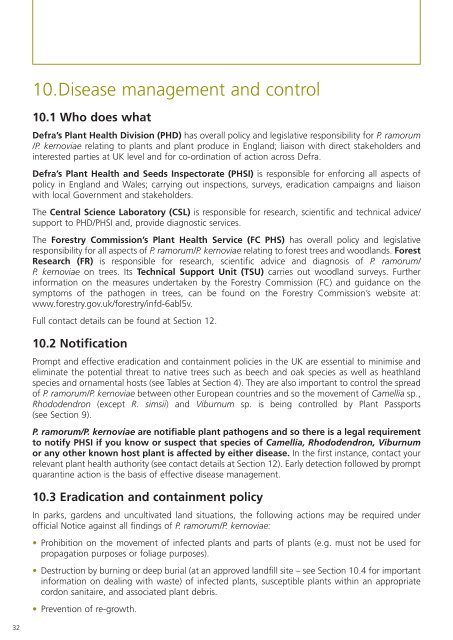Phytophthora ramorum - The Food and Environment Research ...
Phytophthora ramorum - The Food and Environment Research ...
Phytophthora ramorum - The Food and Environment Research ...
You also want an ePaper? Increase the reach of your titles
YUMPU automatically turns print PDFs into web optimized ePapers that Google loves.
10.Disease management <strong>and</strong> control<br />
10.1 Who does what<br />
Defra’s Plant Health Division (PHD) has overall policy <strong>and</strong> legislative responsibility for P. <strong>ramorum</strong><br />
/P. kernoviae relating to plants <strong>and</strong> plant produce in Engl<strong>and</strong>; liaison with direct stakeholders <strong>and</strong><br />
interested parties at UK level <strong>and</strong> for co-ordination of action across Defra.<br />
Defra’s Plant Health <strong>and</strong> Seeds Inspectorate (PHSI) is responsible for enforcing all aspects of<br />
policy in Engl<strong>and</strong> <strong>and</strong> Wales; carrying out inspections, surveys, eradication campaigns <strong>and</strong> liaison<br />
with local Government <strong>and</strong> stakeholders.<br />
<strong>The</strong> Central Science Laboratory (CSL) is responsible for research, scientific <strong>and</strong> technical advice/<br />
support to PHD/PHSI <strong>and</strong>, provide diagnostic services.<br />
<strong>The</strong> Forestry Commission’s Plant Health Service (FC PHS) has overall policy <strong>and</strong> legislative<br />
responsibility for all aspects of P. <strong>ramorum</strong>/P. kernoviae relating to forest trees <strong>and</strong> woodl<strong>and</strong>s. Forest<br />
<strong>Research</strong> (FR) is responsible for research, scientific advice <strong>and</strong> diagnosis of P. <strong>ramorum</strong>/<br />
P. kernoviae on trees. Its Technical Support Unit (TSU) carries out woodl<strong>and</strong> surveys. Further<br />
information on the measures undertaken by the Forestry Commission (FC) <strong>and</strong> guidance on the<br />
symptoms of the pathogen in trees, can be found on the Forestry Commission’s website at:<br />
www.forestry.gov.uk/forestry/infd-6abl5v.<br />
Full contact details can be found at Section 12.<br />
10.2 Notification<br />
Prompt <strong>and</strong> effective eradication <strong>and</strong> containment policies in the UK are essential to minimise <strong>and</strong><br />
eliminate the potential threat to native trees such as beech <strong>and</strong> oak species as well as heathl<strong>and</strong><br />
species <strong>and</strong> ornamental hosts (see Tables at Section 4). <strong>The</strong>y are also important to control the spread<br />
of P. <strong>ramorum</strong>/P. kernoviae between other European countries <strong>and</strong> so the movement of Camellia sp.,<br />
Rhododendron (except R. simsii) <strong>and</strong> Viburnum sp. is being controlled by Plant Passports<br />
(see Section 9).<br />
P. <strong>ramorum</strong>/P. kernoviae are notifiable plant pathogens <strong>and</strong> so there is a legal requirement<br />
to notify PHSI if you know or suspect that species of Camellia, Rhododendron, Viburnum<br />
or any other known host plant is affected by either disease. In the first instance, contact your<br />
relevant plant health authority (see contact details at Section 12). Early detection followed by prompt<br />
quarantine action is the basis of effective disease management.<br />
10.3 Eradication <strong>and</strong> containment policy<br />
In parks, gardens <strong>and</strong> uncultivated l<strong>and</strong> situations, the following actions may be required under<br />
official Notice against all findings of P. <strong>ramorum</strong>/P. kernoviae:<br />
• Prohibition on the movement of infected plants <strong>and</strong> parts of plants (e.g. must not be used for<br />
propagation purposes or foliage purposes).<br />
• Destruction by burning or deep burial (at an approved l<strong>and</strong>fill site – see Section 10.4 for important<br />
information on dealing with waste) of infected plants, susceptible plants within an appropriate<br />
cordon sanitaire, <strong>and</strong> associated plant debris.<br />
• Prevention of re-growth.<br />
32
















